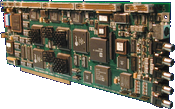Suchergebnis
3 gefundene Erweiterungen
Hersteller NewTek, USA | Datum 1990 | Amiga A2000, A3000, A4000 | Schnittstelle Video-Steckplatz | Autoconfig-ID 2191 / 0 |
Nur englische Beschreibung vorhanden:
- combination of a video switcher, a genlock, a framebuffer and special effects device
- 4× composite inputs (BNC)
- 2× composite outputs (BNC) - Preview and Program
- Input 1 is used to time all the signals to - although the Toaster has its own sync generator, it is recommended to connect a stable external video source here
- requires time base corrected video sources
- stricly a composite device - it works exclusively with composite video signals internally
- NTSC only
- the Video Toaster won the Emmy Award, the broadcast industry's most prestigious award
- still-store
- 2 MB dual frame buffer can hold two 768×400 images in 24 bit
- stores images freezed from incoming video
- digital video effects from one stored image to another
- genlock
- encodes Amiga RGB to composite video
- overlays and dissolves graphics or video on any input source
- Luminance Keyer - allows the superimposing of an actor in front of a background or fly text over video
- software
- Switcher:
- controls the inputs, framebuffer, framegrabber and serves as a launcher for the other Toaster applications
- four banks of digital video effects with over 300 combinations and transitions: flips, tumbles, pulls, spins, smooth fades, standard wipes, transparent cast shadows, synchronized sound effects, positionable windows and one hundred color process effects
- requires at least 3 MB Fast RAM and 1 MB Chip RAM
- ToasterCG:
- 35 ns character generator
- capable of generating up to 100 pages of text using any of the 100 postscript fonts included
- creates titles with scrolls, crawls, graphics, gradient blends, variable transparency and font scaling from 10-400 lines high
- ToasterPaint:
- 24 bit painting
- the interface uses a standard Amiga screen in HAM mode, 768×400 is achieved as a virtual canvas
- image information is maintained inetranally as 24 bit data and can be displayed anytime in 24 bit with the still-store
- LightWave 3D
Hersteller NewTek, USA | Datum 1993 | Amiga A4000 | Schnittstelle Video-Steckplatz |
Nur englische Beschreibung vorhanden:
- successor of the Video Toaster
- when installed in the A4000:
- works much faster than the original Video Toaster and gives A4000 specific features
- full AGA support and new effects particular to the AGA mode
- nine banks of digital video effects
- plugs into the video slot but takes up the space of the Zorro slot above it
- when installed in the A2000 or A3000:
- works slower than the original Video Toaster
- six banks of digital video effects
- triple frame buffers
- the input and output BNC connectors are placed on a removable board - separate versions for A2000 / A3000 / A4000 cases
- new features of v3.0 software
- Character Generator
- Compugraphic and Type 1 font support
- automatic kerning
- over 300 fonts included
- LightWave: animations can be recorded in realtime from the switcher
- new features of v4.1 software
- Switcher
- 600 effects
- customizable interface
- drag and drop effects, CG pages, control elements, Flyer video clips
- Project Editor
- allows building a new switcher, creating slide shows with still stores and effects
- intuitive drag and drop storyboard
- Character Generator
- realtime scaling PostScript brushes, gradient fonts
- realtime display of brushes
- spell checker
- expanded ARexx port
- Toaster Paint
- full screen painting
- support for Flyer clips for rotoscoping, filters and special effects
- global flood fill mode
Hersteller NewTek, USA | Datum 1994 | Amiga A2000, A3000, A4000 | Schnittstelle Zorro II |
- nichtlineares Schnittsystem für Video Toaster und Video Toaster 4000 mit Ausstrahlungsqualität (bandlos)
- Anforderungen:
- Video Toaster mit Software v4.1
- eine SCSI-2-Festplatte für Lightwave-Aufnahme
- drei SCSI-2-Festplatten für A/B-Roll-Editing - zwei für Video, eine für Audio
- bei Video von Videokassetten muss die Zeitbasis korrigiert werden (time base correction)
- Video-Kompression und -Wiedergabe in Echtzeit
- echte Ausstrahlungsqualität - 60 Fields/s, voller Overscanbereich (752×480)
- arbeitet intern mit D2-Daten - keine D2-Composite-Transkodierung
- proprietäre Kompressionsmethode: Video Toaster Adaptive Statistical Coding (VTASC):
- anstelle der Reduzierung der Videoqualität (wie bei JPEG, MPEG, WaveLet) wird das Video-Signal in der Bandbreite reduziert (d.h. Rückfall auf Beta-SP-Qualität)
- keine sichtbaren Pixel - Kompressions-Artefakte zeigen sich als Video-Rauschen, nicht als Block-Strukturen (wie bei JPEG)
- durch schnellere Laufwerke kann verlustlose D2-Qualität erreicht werden
- drei SCSI-Busse (zwei für Video, einer für Audio), an jeden Bus können 7 SCSI-Geräte angeschlossen werden (21 insgesamt)
- zwei serielle Schnittstellen zur Steuerung von entsprechenden Video-Rekordern
- SCSI und die seriellen Ports können mit dem sogenannten Octopus-Kabel ausserhalb des Computers gelegt werden
- Video:
- Einspeisen/Ausgabe des Video-Signals vom/zum Toaster über ein Flachbandkabel
- Sampling-Rate: 14.3 MHz
- Quantisierung mit 8 Bit
- 8 MB Puffer
- Audio-Recorder / -Mixer:
- ADSP2115
- digitale Eingänge
- Video-Disc A und B, links/rechts
- Audio-Disc A und B, links/rechts
- analoge, unsymmetrische Ein-/Ausgänge (Cinch) auf der Backplane der Karte
- Speicher: 64 kB
- Taktrate: 20 MHz
- Sampling: 16 Bit bei 44.1 kHz
- 64-faches Oversampling des A/D-Konverters
- nichtlineares Schnittsystem (nur NTSC)
 Amiga Hardware Database
Amiga Hardware Database



















